
Cannabis pruning: Topping vs fimming
Topping vs fimming are two cannabis pruning techniques that can transform your grow. Learn how each method works, their pros and cons, and which suits your setup best. Boost yields, manage plant shape, and grow with confidence. Read on to find out more.
Wondering whether to top or fim your cannabis plants? Here's how to choose the best method for bigger, healthier yields. Whether you're working with a single plant in a small grow tent or managing a room full of vigorous strains, mastering cannabis pruning techniques is key to unlocking your crop's full potential. Two of the most effective methods, topping and fimming, can dramatically influence how your plants grow, how much they yield, and how manageable they are throughout the grow cycle.
In this guide, we'll break down the differences between topping and fimming, explore their pros and cons, and help you decide which technique best suits your grow space, experience level, and desired outcome. Curious about how to top cannabis? Want to try fimming weed plants? Or, just need a quick side-by-side comparison? This article will give you the confidence to prune with purpose.
Getting to grips with topping and fimming
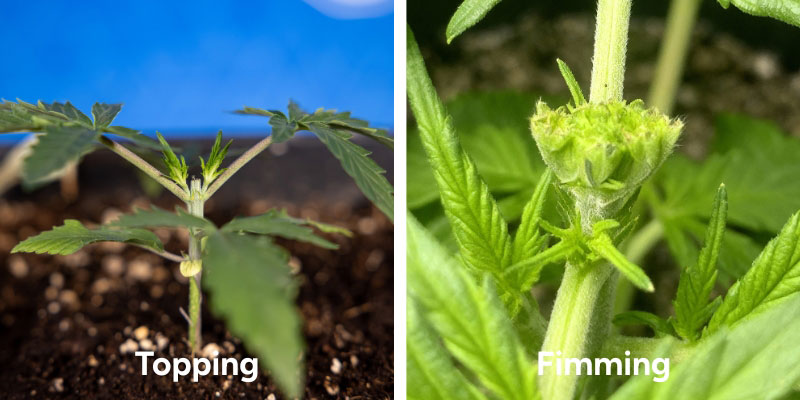
Before comparing the two methods side-by-side, it's useful to understand the basics of each technique. Both topping and fimming are forms of high-stress training (HST) that involve carefully cutting parts of the cannabis plant to redirect growth. Here's how they differentiate.
Topping
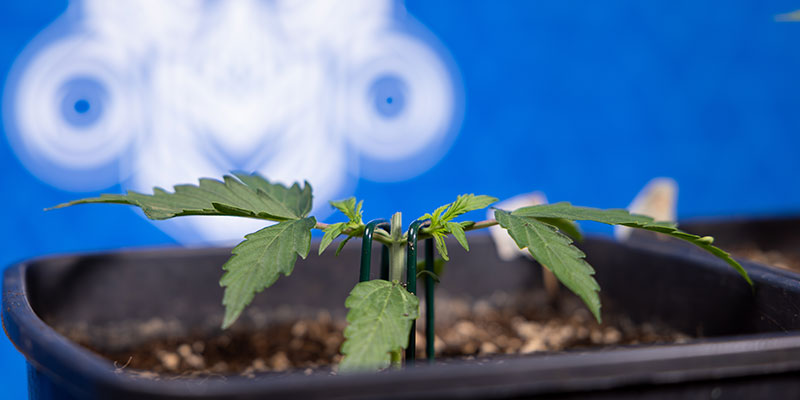
Topping cannabis plants involves cleanly cutting off the very top of the main stem, just above a node. By removing the primary growth tip, the plant redirects energy into the two axillary branches below the cut. This results in two main colas instead of one, giving growers a more even canopy and improved light distribution.
Growers usually top cannabis when plants have developed at least 4–6 nodes, ensuring they are strong enough to recover. Done correctly, topping encourages bushier growth, increases yields, and helps to control plant height, though it does slightly extend the vegetative phase while the plant recovers. For more information, consult our dedicated topping guide here.
Fimming
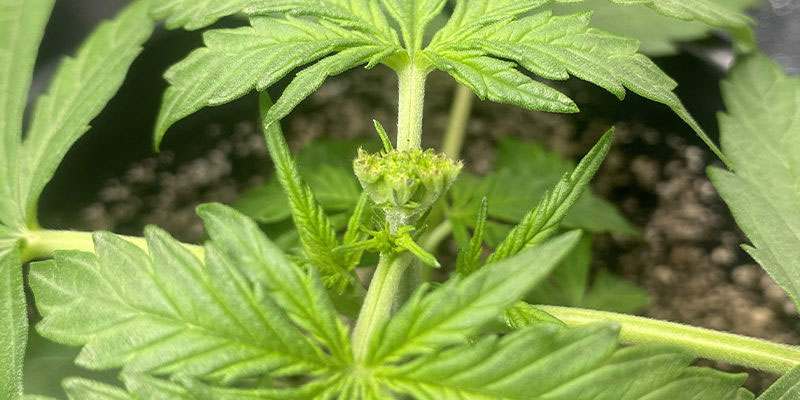
Fimming weed plants is a similar but less precise method. Instead of cutting the entire top growth tip, around 70–80% of the new shoot is pinched or trimmed away. This “missed topping” technique often leads to four or more new colas, making the canopy even bushier and more productive if successful.
Like topping, fimming is best carried out once plants have several healthy nodes, but the less drastic cut means they typically recover a little faster. The results can be less predictable than topping, but when done well, cannabis fimming is an effective way to maximise light exposure and potential bud sites. Curious to know how to fim cannabis plants? Take a look at this in-depth article.
Topping vs fimming: Key differences
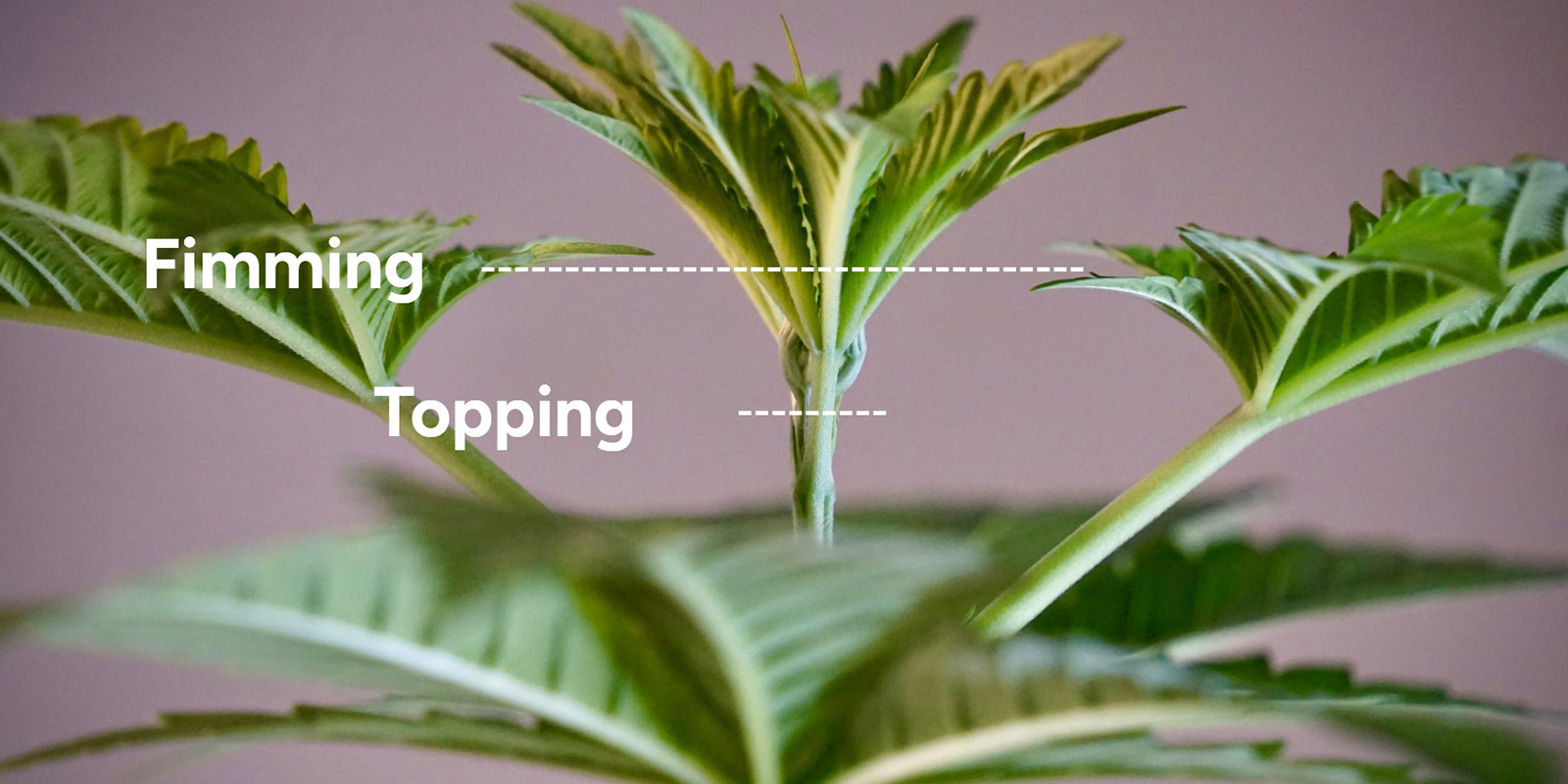
While both pruning methods aim to increase bud sites and create a fuller plant, the way they work and the results they deliver differ in important ways. Understanding these distinctions will help you choose the right approach for your growing space, strain, and level of experience.
Difficulty
When it comes to precision, there's no denying that topping is the more straightforward of the two. You simply cut above a node to create two main colas, making it much easier to predict the result. Fimming, however, requires cutting around 70–80% of the top growth tip. If you cut too high, the plant may continue to grow as if untouched; too low, and you may end up with a topping effect instead. This makes fimming slightly riskier for beginners.
Growth stress
As mentioned, topping and fimming are high-stress training (HST) methods, but they impact plants differently. Topping delivers a clean, decisive cut that shocks the plant, forcing it to redirect growth. Fimming is less severe but will still cause stress to the plant, as a partial cut interferes with standard growth patterns. For growers concerned about plant stress, fimming may be the gentler option, though it can be less predictable.
Recovery
Recovery time is a key factor when planning your grow. After topping, plants will often need a week or more to bounce back before resuming vigorous growth. With fimming, recovery tends to be much faster, taking around 3–5 days in many cases, though the outcome can vary depending on how precisely the cut was made. For growers on tighter schedules, fimming may offer a quicker turnaround.
Strain selection
Not all cannabis strains respond equally to high-stress pruning. Compact, bushy plants generally handle topping and fimming well, while some delicate, slimmer, taller cultivars may be prone to stress or slower recovery. When choosing between these techniques, consider the genetics of your strain as well as your growth goals. For more insight on how different strains respond to training, check out our guide on HST vs LST techniques.
When to use each method
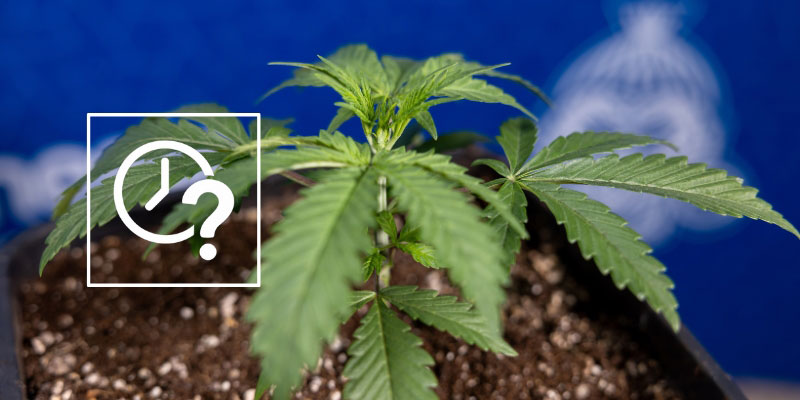
Choosing between topping and fimming often depends on your grow environment, the strain you're cultivating, and your own experience as a grower. While both methods can deliver impressive results, each shines in slightly different situations.
Topping
Topping is often the go-to choice for growers working with limited vertical space, as it helps to keep plants shorter and more manageable. Strains with strong, resilient genetics, particularly indica-dominant hybrids, respond exceptionally well, producing even canopies and solid yields.
In terms of skill, topping cannabis plants is beginner-friendly, thanks to its straightforward process and predictable results. Topping is usually the safest first step if you're new to pruning.
Fimming
Fimming is best suited to growers with a little more experience, as the results depend on making a precise partial cut. This method is ideal when you have extra space for a bushier plant and want to encourage multiple colas from a single cut.
Strains that can handle higher stress, particularly vigorous sativa-dominant varieties, often thrive through fimming. While not overly complex, the technique does require a steady hand and some trial and error, making it better for intermediate growers ready to experiment.
-Desk.jpg)
_Mob.jpg)
Can you fim after topping?
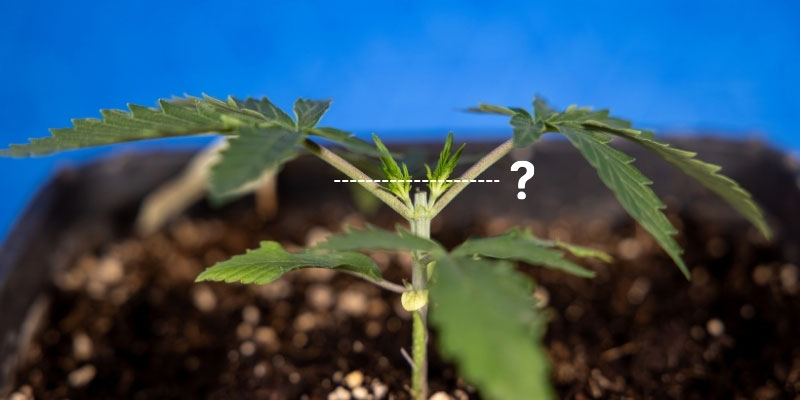
Yes, it's entirely possible to fim a cannabis plant after topping, but timing and plant health are critical. Both techniques fall under high-stress training, which puts the plant under pressure. Applying them too close together can slow recovery, reduce growth, or stunt development if the plant is already stressed.
The best approach is to top cannabis plants first, then allow them to fully recover and establish strong new growth. Once healthy side branches have developed, you can selectively apply fimming to encourage even more colas. This combined strategy can create bushy plants with multiple bud sites but requires patience and careful monitoring.
For most beginner growers, it's recommended to stick with one method per plant until you're comfortable with pruning techniques. More advanced growers may experiment with using both to maximise yields, provided the plant has enough time and resources to recover.
Tools and tips for topping and fimming
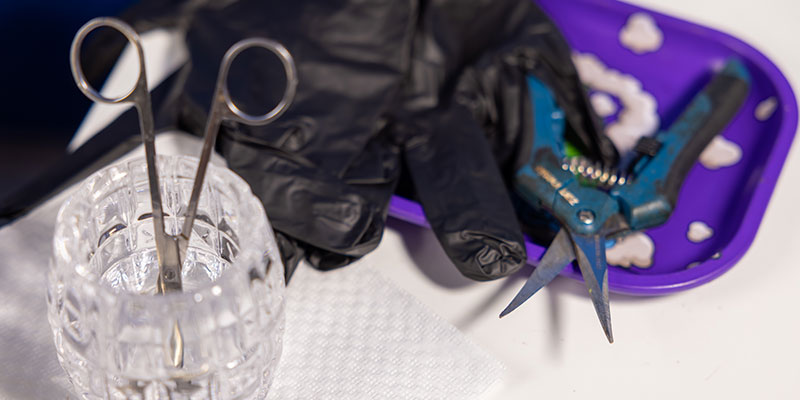
To get the best results from topping or fimming, it's not just about where you cut, but also how you do it. Using the right gear and good technique will reduce the risk of infection, speed up recovery, and keep your plants thriving.
Essential pruning tools
Sharp, clean scissors or shears are crucial for both topping and fimming. A clean cut helps plants heal faster and reduces unnecessary damage. You can find a wide range of reliable pruning tools, from precision scissors to sterilisation products, that make the entire process easier.
Sterilisation matters
Always sterilise your tools before and after use. Cannabis plants are vulnerable to pathogens, and dirty equipment can spread disease quickly. A quick wipe with rubbing alcohol or wipes between cuts is usually enough to keep things safe.
Timing and technique tips
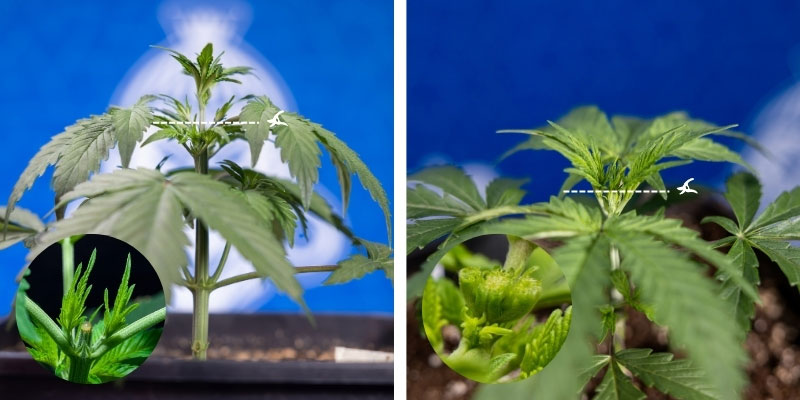
- Wait for 4–6 nodes before making that first cut as plants need a strong base to recover from HST.
- Top cannabis plants cleanly just above a node for predictable results.
- For fimming, carefully pinch or cut about 70–80% of the growth tip. Too high or too low, and the effect won't be the same,
- Avoid pruning when plants are already stressed (from transplanting, overwatering, or nutrient issues). Healthy plants recover quickly and respond better.
Aftercare
After topping or fimming, giving your plants time to rest is essential. Maintain steady light cycles, avoid additional stressors, and ensure that they have adequate nutrients. Within days to a week, you'll see new shoots forming and your plant redirecting its energy.
Potential risks and how to avoid them
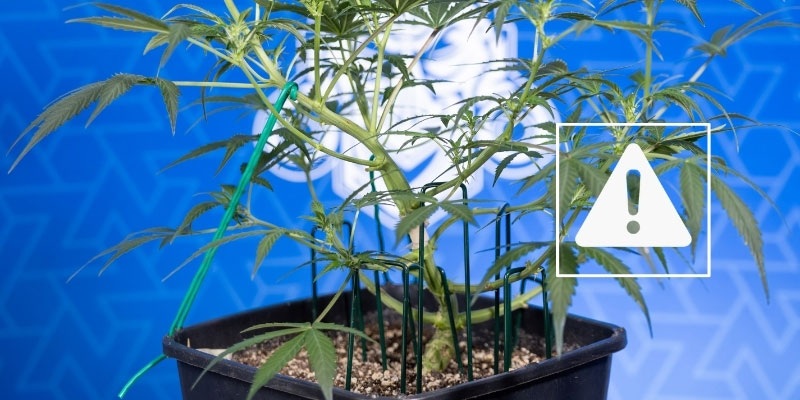
While topping and fimming have the potential to significantly boost yields, they also come with risks if not done correctly. Being aware of these possible pitfalls and how to avoid them will keep your plants healthy and productive.
Over-pruning and plant shock
While both techniques evoke high stress levels in your plants, they should only be performed during the vegetative stage. Plants need a strong root system and several growth nodes before they can bounce back effectively. If you prune too early, too often, or during flowering, you risk stunting growth or reducing yields altogether.
Strain considerations
Not every cannabis strain responds equally well to high-stress training. Autoflowering strains, for example, have a fixed growth cycle and often don't have enough time to recover from topping or fimming before they begin flowering. While some advanced growers experiment with this, beginners are better off sticking to feminized photoperiod strains, allowing more flexibility and recovery time.
Before deciding on whether to top or fim cannabis, research your cultivar's tolerance for stress. As discussed, indica-dominant and hybrid strains tend to be a little more forgiving, while sativas can be a little delicate and may struggle.
Structural issues
One side effect of successful fimming is the production of multiple colas, which can make plants heavy at the top. This can cause branches to droop or even snap without the proper support. Using stakes, trellis netting, or plant ties will help to stabilise your canopy and protect your crop from collapse.
What is best for weed plants: fimming or topping?
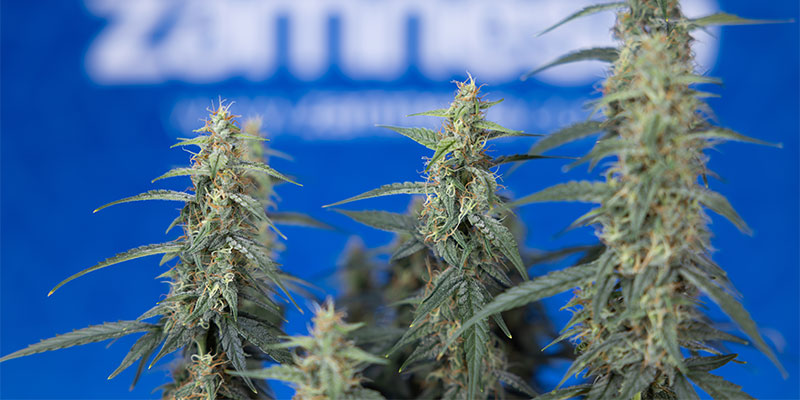
When it comes to topping vs. fimming, there's no single “best” choice; it depends on your grow goals and setup. Topping cannabis plants is predictable, beginner-friendly, and ideal for keeping plants short and manageable, though it requires a slightly longer recovery period. Fimming weed plants can produce more colas in less time, but results can be inconsistent, and the technique demands a bit more precision.
In short:
- Topping: reliable, controlled growth with two strong main colas.
- Fimming: bushier plants with the potential for multiple bud sites, but greater variability.
If you're new to high-stress training techniques, topping is often the safest place to start. More experienced growers, or those with vigorous strains and extra space, may find fimming a rewarding way to push yields further.
Whichever technique you choose, the key is to match your method to your plants and their environment. For the best results possible, start with strong genetics. Explore our wide range of cannabis seeds that respond well to heavy pruning and training.
-
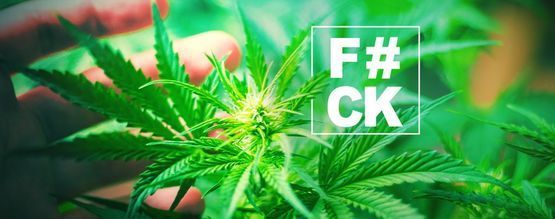 5 min
3 November 2025
Fimming cannabis for bigger yields: When and how to FIM your...
Want to boost your cannabis harvest without more plants? Fimming (short for “F*ck I Missed”) is a simple pruning trick that creates bushier plants with multiple new colas. Learn how it works, when...
5 min
3 November 2025
Fimming cannabis for bigger yields: When and how to FIM your...
Want to boost your cannabis harvest without more plants? Fimming (short for “F*ck I Missed”) is a simple pruning trick that creates bushier plants with multiple new colas. Learn how it works, when...
-
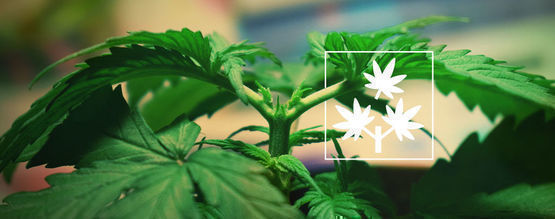 5 min
13 October 2025
Topping cannabis: Everything you need to know
Topping cannabis is a simple pruning technique that can transform tall, single-cola plants into bushier, higher-yielding ones. This guide explains when and how to top a weed plant, the differences...
5 min
13 October 2025
Topping cannabis: Everything you need to know
Topping cannabis is a simple pruning technique that can transform tall, single-cola plants into bushier, higher-yielding ones. This guide explains when and how to top a weed plant, the differences...
-
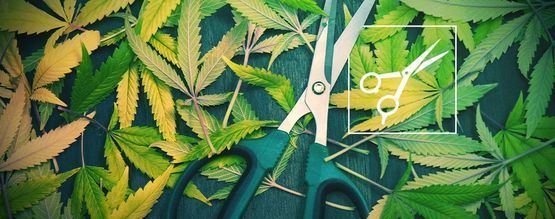 3 min
9 October 2019
Pruning: Everything You Need To Know
Pruning cannabis is a hotly debated topic in the grow community. One side believes that purposeful, controlled pruning can increase yields by a substantial margin, while the other is sure that...
3 min
9 October 2019
Pruning: Everything You Need To Know
Pruning cannabis is a hotly debated topic in the grow community. One side believes that purposeful, controlled pruning can increase yields by a substantial margin, while the other is sure that...
-
 3 min
29 August 2018
Top 4 Pruning Techniques For Your Cannabis Plants
Could you use a fatter stash of marijuana? Of course you could! We’ve got 4 pruning for yield techniques to show you that pro growers have been using for decades to boost bud production. Give these...
3 min
29 August 2018
Top 4 Pruning Techniques For Your Cannabis Plants
Could you use a fatter stash of marijuana? Of course you could! We’ve got 4 pruning for yield techniques to show you that pro growers have been using for decades to boost bud production. Give these...






 United States
United States











